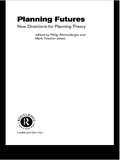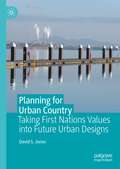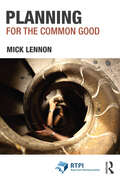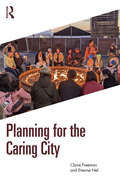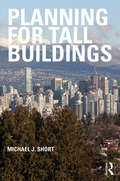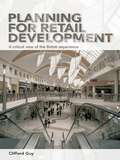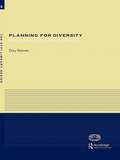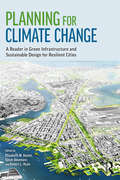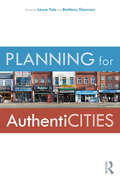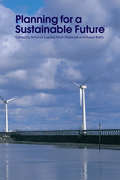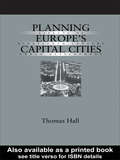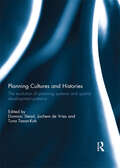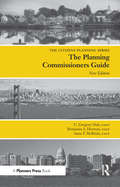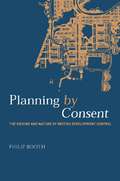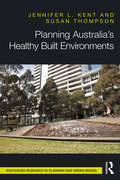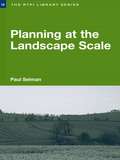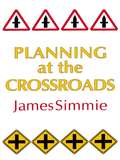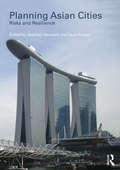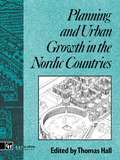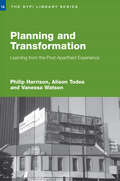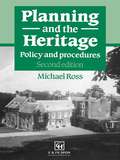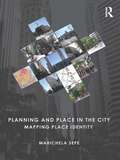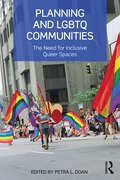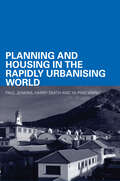- Table View
- List View
Planning Futures: New Directions for Planning Theory
by Philip Allmendinger Mark Tewdwr-JonePlanning theory is currently in a confused state as a consequence of a number of changes over the last ten years in planning practice and social and economic theory. Even prior to these events, planning theory was an uncertain discipline, reflecting planning's precarious position between and resting upon a range of professional subject areas and philosophical roots. Planning Futures is an attempt to pin down the constantly evolving landscape of planning theory and to chart a path through this fast changing field.Planning Futures is an up-to-date reader on planning theory, but adds something more to the subject area than a mere textbook. The contributors have attempted to bridge theory and practice while putting forward new theoretical ideas. By drawing upon examples from planning practice and case study scenarios, the authors ensure that the work discusses planning theory within the context of present planning practice. Case studies are drawn from an international arena, from the UK, Europe, South Africa and Australia.
Planning for Urban Country: Taking First Nations Values into Future Urban Designs
by David S. JonesPlanning for Urban Country addresses a major gap in knowledge about the translation of Aboriginal values and Country Plans into Australia’s built environment contexts. How do you ‘heal’ Country if it has been devastated by concrete and bitumen, excavations and bulldozing, weeds and introduced plants and animals, and surface, aerial and underground contaminants? How then do Aboriginal values and Country Plan aspirations address urban environments? In this book, David Jones explores the major First Nations-informed design and planning transformations in Djilang / Greater Geelong since 2020. Included are short-interlinked essays about the political and cultural context, profiles of key exemplar architectural, landscape and corridor projects, a deep explanation of the legislative, policy and statutory precedents, opportunities and environment that has enabled these opportunities, and the how Wadawurrung past-present-future values have been scaffolded into these changes.
Planning for the Common Good (RTPI Library Series)
by Mick LennonAppeals to the ‘common good’ or ‘public interest’ have long been used to justify planning as an activity. While often criticised, such appeals endure in spirit if not in name as practitioners and theorists seek ways to ensure that planning operates as an ethically attuned pursuit. Yet, this leaves us with the unavoidable question as to how an ethically sensitive common good should be understood. In response, this book proposes that the common good should not be conceived as something pre-existing and ‘out there’ to be identified and applied or something simply produced through the correct configuration of democracy. Instead, it is contended that the common good must be perceived as something ‘in here,’ which is known by engagement with the complexities of a context through employing the interpretive tools supplied to one by the moral dimensions of the life in which one is inevitably embedded. This book brings into conversation a series of thinkers not normally mobilised in planning theory, including Paul Ricoeur, Alasdair MacIntyre and Charles Taylor. These shine light on how the values carried by the planner are shaped through both their relationships with others and their relationship with the ‘tradition of planning’ – a tradition it is argued that extends as a form of reflective deliberation across time and space. It is contended that the mutually constitutive relationship that gives planning its raison d’être and the common good its meaning are conceived through a narrative understanding extending through time that contours the moral subject of planning as it simultaneously profiles the ethical orientation of the discipline. This book provides a new perspective on how we can come to better understand what planning entails and how this dialectically relates to the concept of the common good. In both its aim and approach, this book provides an original contribution to planning theory that reconceives why it is we do what we do, and how we envisage what should be done differently. It will be of interest to scholars, students and practitioners in planning, urban studies, sociology and geography.
Planning for the Caring City
by Claire Freeman Etienne NelAs the world has become increasingly urbanised and planetary well-being ever more threatened, questions have emerged over just what the priorities should be for how we live in cities. Clearly for many the current ways of planning and managing city environments are not working, given so many of their human and non-human inhabitants struggle on a daily basis to maintain their well-being and survival. Different approaches to city development are crucial if they are to be inclusive places where all can thrive. Ensuring that cities are safe and sustainable and provide a level of care for all their residents places a significant mandate on those who manage cities and on planners in particular. This book examines all the parts of the city where care needs to be incorporated, how we plan, create nurturing environments, include all who live there, build sensitively, support meaningful livelihoods, and enable compassionate governance. With planners in mind this book examines why care is needed in the urban environment, and drawing on real world examples examines how it can be applied in an effective and empowering fashion.
Planning for Tall Buildings
by Michael J. ShortIn a time of recession, the challenge of building and planning for tall buildings has become even more complex; the economics of development, legislative and planning frameworks, and the local politics of development must be navigated by those wishing to design and construct new tall buildings which fit within the fabric of their host cities. This book is a timely contribution to the debate about new tall buildings and their role and effect on our cities. It is divided into two main parts. In part one, the relationship between tall buildings and planning is outlined, followed by an exploration of the impacts that construction of tall buildings can have. It focuses, in particular, on the conservation debates that proposals for new tall buildings raise. The first part ends with an analysis of the way in which planning strategies have evolved to deal with the unique consequences of tall buildings on their urban locations. The second part of the book focuses on seven examples of medium-sized cities dealing with planning and conservation issues, and implications that arise from tall buildings. These have been chosen to reflect a wide range of methods to either encourage or to control tall buildings that cities are deploying. The case studies come from across the western world, covering England (Manchester, Liverpool, Newcastle and Birmingham), Norway (Oslo), Ireland (Dublin) and Canada (Vancouver) and represent a broad spectrum of approaches to dealing with this issue.In drawing together the experiences of these varied cities, the book contributes to the ongoing debate about the role of the tall building in our cities, their potential impacts, and experiences of those who use and inhabit them. The conclusions outline how cities should approach the strategic planning of tall buildings, as well as how they should deal with the consequences of individual buildings, particularly on the built heritage.
Planning for Retail Development: A Critical View of the British Experience
by Clifford GuyWritten by a leading expert in the field, this is the first thorough critical review of retail planning policy in Britain (including Scotland and Wales). It covers recent changes in government policy and guidance, and examines retail policy within a broader economic and social context. Planning for Retail Development explains key events and debates in the evolution of retail planning policy, at central and local government levels, since the 1960s and draws contrasts between the 1980s, a period in which retail developers were encouraged by central government to expand away from town centres, and the more recent emphasis on protection and promotion of town centres as the most appropriate location for new development. The book develops a critical evaluation of past and present retail planning policies, based upon analyses of retailers’ objectives and of typical consumer shopping behaviour. Relationships between retail planning and wider societal concerns, including sustainable development, social inclusion and urban regeneration are also examined and analysed and guidelines for future policy objectives and content are drawn.
Planning for Diversity: Policy and Planning in a World of Difference (RTPI Library Series #Vol. 8)
by Dory ReevesThe practical importance of diversity and equality for spatial planning and sustainable development is still not widely understood. Using international examples, this book shows planners and educationalists the benefits of building in a consideration of diversity and equality at each stage and level of planning.Despite being one of the most diverse and gender balanced of the built environment professions, complacency has been widespread in planning. This book shows why a diverse profession is important and drawing on a wide range of good practice, shows how those involved in planning can develop their sensitivity to and expertise in diversity and equality.
Planning for Crime Prevention: A Transatlantic Perspective (RTPI Library Series #Vol. 3)
by Ted Kitchen Richard H SchneiderCrime and the fear of crime are issues high in public concern and on political agendas in most developed countries. This book takes these issues and relates them to the contribution that urban planners and participative planning processes can make in response to these problems. Its focus is thus on the extent to which crime opportunities can be prevented or reduced through the design, planning and management of the built environment. The perspective of the book is transatlantic and comparative, not only because ideas and inspiration in this and many other fields increasingly move between countries but also because there is a great deal of relevant theoretical material and practice in both the USA and the UK which has not previously been pulled together in this systemic manner.
Planning for Climate Change: A Reader in Green Infrastructure and Sustainable Design for Resilient Cities
by Elisabeth M. Hamin Infield Yaser Abunnasr Robert L. RyanThis book provides an overview of the large and interdisciplinary literature on the substance and process of urban climate change planning and design, using the most important articles from the last 15 years to engage readers in understanding problems and finding solutions to this increasingly critical issue. The Reader’s particular focus is how the impacts of climate change can be addressed in urban and suburban environments—what actions can be taken, as well as the need for and the process of climate planning. Both reducing greenhouse gas emissions as well as adapting to future climate are explored. Many of the emerging best practices in this field involve improving the green infrastructure of the city and region—providing better on-site stormwater management, more urban greening to address excess heat, zoning for regional patterns of open space and public transportation corridors, and similar actions. These actions may also improve current public health and livability in cities, bringing benefits now and into the future. This Reader is innovative in bringing climate adaptation and green infrastructure together, encouraging a more hopeful perspective on the great challenge of climate change by exploring both the problems of climate change and local solutions.
Planning for AuthentiCITIES
by Laura Tate Brettany ShannonAuthenticity resonates throughout the urbanizing world. As cities’ commercial corridors and downtowns start to look increasingly the same, and gentrification displaces many original neighborhood residents, we are left with a sense that our cities are becoming "hollowed out," bereft of the multi-faceted connections that once rooted us to our communities. And yet, in a world where change is unrelenting, people long for authentic places. This book examines the reasons for and responses to this longing, considering the role of community development in addressing community and neighbourhood authenticity. A key concept underscoring planning’s inherent challenges is the notion of authentic community, ranging from more holistic, and yet highly market-sensitive conceptions of authentic community to appreciating how authenticity helps form and reinforce individual identity. Typically, developers emphasize spaces’ monetary exchange value, while residents emphasize neighbourhoods’ use value—including how those spaces enrich local community tradition and life. Where exchange value predominates, authenticity is increasingly implicated in gentrification, taking us further from what initially made communities authentic. The hunger for authenticity grows, in spite and because of its ambiguities. This edited collection seeks to explore such dynamics, asking alternately, "How does the definition of ‘authenticity’ shift in different social, political, and economic contexts?" And, "Can planning promote authenticity? If so, how and under what conditions?" It includes healthy scepticism regarding the concept, along with proposals for promoting its democratic, inclusive expression in neighbourhoods and communities.
Planning for a Sustainable Future
by Antonia Layard Simin Davoudi Susan BattySustainable Development is now firmly on the planning agenda and is an issue neither practitioner nor academic can afford to ignore. Planning for a Sustainable Future provides a multi-disciplinary overview of sustainability issues in the land use context, focusing on principles and their application, the legal, political and policy context and the implication of sustainable development thinking for housing, urban design and property development as well as waste and transport. The book concludes by considering how sustainable and unsustainable impacts alike can be measured and modelled, providing real tools to move beyond rhetoric into practice.
Planning Europe's Capital Cities: Aspects of Nineteenth-Century Urban Development (Planning, History and Environment Series)
by Thomas HallDuring the nineteenth century many of Europe's capital cities were subject to major expansion and improvement schemes. From Vienna's Ringstrasse to the boulevards of Paris, the townscapes which emerged still shape today's cities and are an inalienable part of European cultural heritage.In Planning Europe's Capital Cities, Thomas Hall examines the planning process in fifteen of those cities and addresses the following questions: when and why did planning begin, and what problems was it meant to solve? who developed the projects, and how, and who made the decisions? what urban ideas are expressed in the projects? what were the legal consequences of the plans, and how did they actually affect subsequent urban development in the individual cities? what similarities or differences can be identified between the various schemes? how have such schemes affected the development of urban planning in general?His detailed analysis shows us that the capital city projects of the nineteenth century were central to the evolution of modern planning and of far greater impact and importance than the urban theories and experiments of the Utopians.
Planning Cultures and Histories: The evolution of Planning Systems and Spatial Development Patterns
by Dominic Stead, Jochem de Vries and Tuna Tasan-KokThis book addresses the influences of planning cultures and histories on the temporal evolution of planning systems and spatial development. As well as providing an international comparative perspective on these issues, the contributions to the book also engage in a search for new conceptual frameworks and alternative points of view to better understand and explain these differences. The book makes three main academic contributions. First, it catalogues some of the key changes in planning systems and the impact on spatial development patterns. Second, it examines the interrelationship between planning cultures and histories from a path-dependency perspective. Third, it discusses the variations in physical development patterns resulting from different planning cultures and histories. Chapters from different parts of the European continent present evidence at different scales to illustrate these aspects. In all cases, the specific combinations of political, ideological, social, economic and technological factors are important determinants of urban and regional planning trajectories as well as spatial development patterns. This book was previously published as a special issue of European Planning Studies.
Planning Commissioners Guide: Processes for Reasoning Together
by C Gregory Dale Benjamin A Herman Anne McBrideAcross the country, communities rely on their planning commissions for guidance. But who guides the planning commissioners? This step-by-step guidebook gets new commissioners off on the right foot and helps experienced commission members navigate their roles. The authors, all practicing planners, have worked extensively with planning commissions for decades. They have watched commissioners scramble up a steep learning curve, sit in the hot seat of controversy, and strive to make sound decisions for the places they call home. In this helpful handbook, the authors share ideas, insights, and information to help commissioners succeed. Eight detailed chapters cover everything from the nuts and bolts of development applications to the nuances of legal issues to the part commissioners play in long-range planning. Readers will learn how to prepare for their first commission meeting, review a development plan, invite productive public input, and steer clear of ethical dilemmas. Added resources include a glossary of planning terms, a list of training resources, and the American Planning Association’s Statement of Ethical Principles in Planning. For anyone serving on a planning commission, The Planning Commissioners Guide is essential reading.
Planning by Consent: The Origins and Nature of British Development Control (Planning, History and Environment Series)
by Philip Booth**Please note this is an unedited paperback reprint of the hardback, originally published in 2003** The British system of universal development control celebrated its 50th anniversary in 1997. Remarkably, the system has survived more or less intact but the experience of the 1980s has left large questions unanswered about the relevance and effectiveness of the system. This book traces the history of the development control system in Britain from early modern times to the present day.
Planning Australia’s Healthy Built Environments
by Jennifer L. Kent Susan ThompsonPlanning Australia’s Healthy Built Environments shines a quintessentially Australian light on the links between land use planning and human health. A burgeoning body of empirical research demonstrates the ways urban structure and governance influences human health—and Australia is playing a pivotal role in developing understandings of the relationships between health and the built environment. This book takes a retrospective look at many of the challenges faced in pushing the healthy built environment agenda forward. It provides a clear and theoretically sound framework to inform this work into the future. With an emphasis on context and the pursuit of equity, Jennifer L. Kent and Susan Thompson supply specific ways to better incorporate idiosyncrasies of place and culture into urban planning interventions for health promotion. By chronicling the ways health and the built environment scholarship and practice can work together, Planning Australia’s Healthy Built Environments enters into new theoretical and practical debates in this critically important area of research. This book will resonate with both health and built environment scholars and practitioners working to create sustainable and health-supportive urban environments.
Planning at the Landscape Scale (RTPI Library Series #Vol. 12)
by Paul SelmanTraditionally, landscape planning has involved the designation and protection of exceptional countryside. However, whilst this still remains important, there is a growing recognition of the multi-functionality of rural areas, and the need to encourage sustainable use of the whole countryside rather than just its ‘hotspots’. With an inter-disciplinary assessment of the rural environment, this book draws on theories of landscape values, people-place relationships, sustainable development, and plan implementation. It focuses on the competing influences of globalization and localization, seeing the role of planning as the reconciliation of these conflicting demands, reinforcing character and distinctiveness without museum-izing rural areas. Taking a ‘landscape scale’ approach to the topic, this book responds to the interest sparked by concern for rural landscapes and by recent local and national policy shifts in this area.
Planning At The Crossroads
by James SimmieThrough a detailed analysis of studies of the effects of planning, comparing low levels of urban containment in California with much higher levels in the UK. Some comparative insights are also drawn from the (pre-conflict) Yugoslavian planning system. The analysis shows that many of the serious criticisms of planning are valid and leads to the conclusion that some sacred cows - notably "green belts" - should be abandoned. This distinctive text is of use to students, researchers and professionals in planning, geography and urban studies.
Planning Asian Cities: Risks and Resilience (Planning, History and Environment Series)
by Stephen Hamnett Dean ForbesIn Planning Asian Cities: Risks and Resilience, Stephen Hamnett and Dean Forbes have brought together some of the region’s most distinguished urbanists to explore the planning history and recent development of Pacific Asia’s major cities. They show how globalization, and the competition to achieve global city status, has had a profound effect on all these cities. Tokyo is an archetypal world city. Singapore, Hong Kong and Seoul have acquired world city characteristics. Taipei and Kuala Lumpur have been at the centre of expanding economies in which nationalism and global aspirations have been intertwined and expressed in the built environment. Beijing, Hong Kong and Shanghai have played key, sometimes competing, roles in China’s rapid economic growth. Bangkok’s amenity economy is currently threatened by political instability, while Jakarta and Manila are the core city-regions of less developed countries with sluggish economies and significant unrealized potential. But how resilient are these cities to the risks that they face? How can they manage continuing pressures for development and growth while reducing their vulnerability to a range of potential crises? How well prepared are they for climate change? How can they build social capital, so important to a city’s recovery from shocks and disasters? What forms of governance and planning are appropriate for the vast mega-regions that are emerging? And, given the tradition of top-down, centralized, state-directed planning which drove the economic growth of many of these cities in the last century, what prospects are there of them becoming more inclusive and sensitive to the diverse needs of their populations and to the importance of culture, heritage and local places in creating liveable cities?
Planning and Urban Growth in Nordic Countries (Planning, History and Environment Series)
by Thomas HallPlanning and Urban Growth in Nordic Countries examines urban development and planning in Denmark, Finland, Norway and Sweden. Emphasis is on the period from the mid-nineteenth century to the present day, and the authors of each 'country-study' look at their own national developments against the background of those in other Nordic countries well as the rest of Europe and the USA.
Planning and Transformation: Learning from the Post-Apartheid Experience (RTPI Library Series)
by Vanessa Watson Alison Todes Philip HarrisonPlanning and Transformation provides a comprehensive view of planning under political transition in South Africa, offering an accessible resource for both students and researchers in an international and a local audience. In the years after the 1994 transition to democracy in South Africa, planners believed they would be able to successfully promote a vision of integrated, equitable and sustainable cities, and counter the spatial distortions created by apartheid. This book covers the experience of the planning community, the extent to which their aims were achieved, and the hindering factors. Although some of the factors affecting planning have been context-specific, the nature of South Africa’s transition and its relationship to global dynamics have meant that many of the issues confronting planners in other parts of the world are echoed here. Issues of governance, integration, market competitiveness, sustainability, democracy and values are significant, and the particular nature of the South African experience lends new insights to thinking on these questions, exploring the possibilities of achievement in the planning field.
Planning and the Heritage: Policy and procedures
by Michael RossThis is a clear guide to heritage legislation in the UK. It is set out in plain, non-legal language and will guide the planner, developer, architect or conservationist through the legislation, explaining the policy and procedures which govern the protection of historic buildings as well as providing clear explanations of the issues involved, including listing, planning appeals and grants.
Planning and Place in the City: Mapping Place Identity
by Marichela SepeUnder the influence of globalization, the centres of many cities in the industrialised world are losing their place identity, the set of cultural markers that define a city’s uniqueness and make it instantly recognisable. A key task for planners and residents, working together, is to preserve that unique sense of place without making the city a parody of itself. In Planning and Place in the City, Marichela Sepe explores the preservation, reconstruction and enhancement of cultural heritage and place identity. She outlines the history of the concept of placemaking, and sets out the range of different methods of analysis and assessment that are used to help pin down the nature of place identity. This book also uses the author's own survey-based method called PlaceMaker to detect elements that do not feature in traditional mapping and identifies appropriate planning interventions. Case studies investigate cities in Europe, North America and Asia, which demonstrate how surveys and interviews can be used to draw up an analytical map of place identity. This investigative work is a crucial step in identifying cultural elements which will influence what planning decisions should be taken in the future. The maps aim to establish a dialogue with local residents and support planners and administrators in making sustainable changes. The case studies are amply illustrated with survey data sheets, photos, and coloured maps. Innovative and broad-based, Planning and Place in the City lays out an approach to the identification and preservation of place and cultural heritage suitable for students, academics and professionals alike.
Planning and LGBTQ Communities: The Need for Inclusive Queer Spaces
by Petra L. DoanAlthough the last decade has seen steady progress towards wider acceptance of lesbian, gay, bisexual, transgendered, and queer (LGBTQ) individuals, LGBTQ residential and commercial areas have come under increasing pressure from gentrification and redevelopment initiatives. As a result many of these neighborhoods are losing their special character as safe havens for sexual and gender minorities. Urban planners and municipal officials have sometimes ignored the transformation of these neighborhoods and at other times been complicit in these changes. Planning and LGBTQ Communities brings together experienced planners, administrators, and researchers in the fields of planning and geography to reflect on the evolution of urban neighborhoods in which LGBTQ populations live, work, and play. The authors examine a variety of LGBTQ residential and commercial areas to highlight policy and planning links to the development of these neighborhoods. Each chapter explores a particular urban context and asks how the field of planning has enabled, facilitated, and/or neglected the specialized and diverse needs of the LGBTQ population. A central theme of this book is that urban planners need to think "beyond queer space" because LGBTQ populations are more diverse and dispersed than the white gay male populations that created many of the most visible gayborhoods. The authors provide practical guidance for cities and citizens seeking to strengthen neighborhoods that have an explicit LGBTQ focus as well as other areas that are LGBTQ-friendly. They also encourage broader awareness of the needs of this marginalized population and the need to establish more formal linkages between municipal government and a range of LGBTQ groups. Planning and LGBTQ Communities also adds useful material for graduate level courses in planning theory, urban and regional theory, planning for multicultural cities, urban geography, and geographies of gender and sexuality.
Planning and Housing in the Rapidly Urbanising World (Housing, Planning and Design Series)
by Paul Jenkins Harry Smith Ya Ping WangWritten specifically as a teaching text and authored by a team of leading academics in the field, this is the first book to bring together the key issues of rapid urbanisation with approaches to planning and housing. Outlining and explaining core concepts from ‘informal settlements’ to ‘sustainability’, it focuses on the rapid urbanization of developing countries with case studies from Latin America, Asia and Sub-Saharan Africa. The impact of rapid urbanization and associated globalization on land-use and housing is described and analyzed with reference to the particular issues of poverty, health and the environment of these areas. Providing an accessible introduction to the key issues as well as enhancing current theoretical debates and exploring practical applications, this book is an essential resource for students and researchers in this area.
